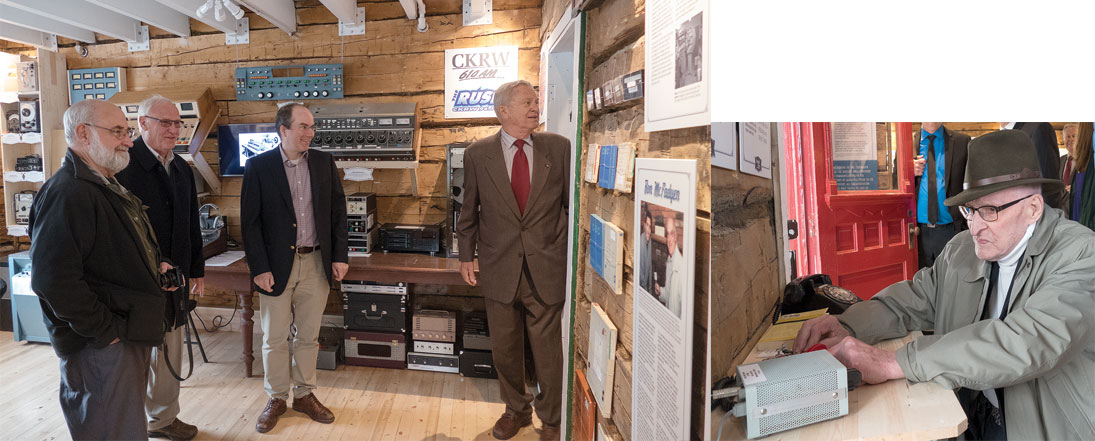Memories rekindled as Telegraph Office reopens
With the grand reopening of the Telegraph Office last Wednesday, Yukoners were reminded of a time before Snapchat, Whatsapp and Facetime.
By Sidney Cohen on May 30, 2016
With the grand reopening of the Telegraph Office last Wednesday, Yukoners were reminded of a time before Snapchat, Whatsapp and Facetime.
About 300 people came out to celebrate the MacBride Museum’s new exhibit about how Yukoners communicated with the Outside prior to the digital age.
Opening the historic site to the public was made possible, in large part, because of a donation from Rolf Hougen, head of the Yukon retail institution Hougen Group of Companies.
Hougen was the guest of honour at last Wednesday’s event.
Under a large white tent set up next to the historic cabin in downtown Whitehorse, he explained his desire to share the territory’s telecommunications history.
“The Royal Canadian Corps of Signals, they were in every community in the North ... they had maybe nine or 10 (personnel) here in Whitehorse, and they did the Morse code all the time to keep people in touch,” Hougen said from a podium at the front of the tent.
“That story is more or less lost to the public, and it should be told, and there are countless other stories of landlines and White Pass and all of these that should be recorded.”
Commissioner Doug Phillips reflected back to when tuning into the Toronto Maple Leafs game up north wasn’t so easy.
“I remember my dad and a bunch of his buddies used to get together and they’d find out who was new in town, and they’d make a wager with the new person about who would win the Saturday night hockey game,” he said.
“The reason was, the game was a week old. The person they were wagering with didn’t realize that (my dad and his friends) had already won. And those were the days that the Maple Leafs had a team in the NHL.”
Mayor Dan Curtis and Premier Darrell Pasloski also shared stories from the pre-Netflix era. They paid tribute to Hougen, the man who was instrumental in creating homegrown TV and radio in the Yukon.
“Yukon became a pioneer in (the telecommunications) sector thanks to Rolf and many other forward-thinking investors, innovators and partners,” said the premier.
“Despite Yukon’s small population, Rolf and others set about working together to improve radio and television for Yukoners.”
In 1958, as president of Northern Television Systems, Hougen helped launch WHTV. For four hours a day, the local channel aired black and white programming that was six months old.
This involved the costly exercise of flying in 200 pounds of tape from Vancouver every day, Pasloski noted.
About a decade later, Hougen put CKRW on the dial as the first commercial radio station in the North.
“Rolf has been a leader and entrepreneur through all of these changes in Yukon’s telecommunications,” said Pasloski.
About 10 years ago, Hougen approached Tourism and Culture Minister Elaine Taylor and Patricia Cunnin, the MacBride Museum’s executive director, about telling the story of telecommunications in the Yukon.
Since then, dozens more have expressed interest in seeing this piece of the Yukon’s history shared, said Cunning, “so we, MacBride, decided that we should tell that story.”
With its weathered exterior and red-trimmed windows, the 1 1/2-storey log cabin on First Avenue is a conspicuous feature on Whitehorse’s riverfront, but few know its history and the importance it had to Yukoners at the turn of the century.
Built in 1900, the Telegraph Office is the oldest building in its original location in Whitehorse, and one of only two buildings in the city that are more than 110 years old.
For 27 years after its construction, the Telegraph Office connected the influx of prospectors to the rest of the country.
Back then, the only way to send a message to the Outside was to transmit it across a single telegraph line that ran south from Dawson City to Whitehorse along the Yukon River, and down through Ashcroft, B.C. to Vancouver.
The cabin was a workplace and residence to its operators until the telegraph became obsolete.
The RCMP used the building briefly in the 1920s, and after that, it was the Boy Scouts headquarters.
In 1952, the cabin was made into a museum, but for the last 30 years, the doors have been locked and windows shuttered.
“My dad told me that this was Sam McGee’s cabin,” Curtis told the audience, pointing to the Telegraph Office behind him.
“Imagine my shock when I find out, from the McBride Museum, that it’s actually the telegraph spot.”
The mayor commended the Front Street museum for recording the Yukon’s history and expanding upon it with the new telecommunications exhibit.
“It’s so, so important to be stewards of our heritage,” he said.
The Telegraph Office is open for tours twice a day and is accessible with admission to the museum.

Comments (1)
Up 0 Down 0
bob geary on Jun 1, 2016 at 5:37 pm
GREAT story